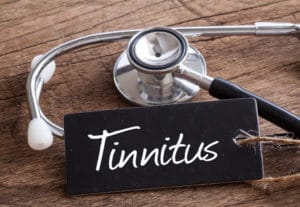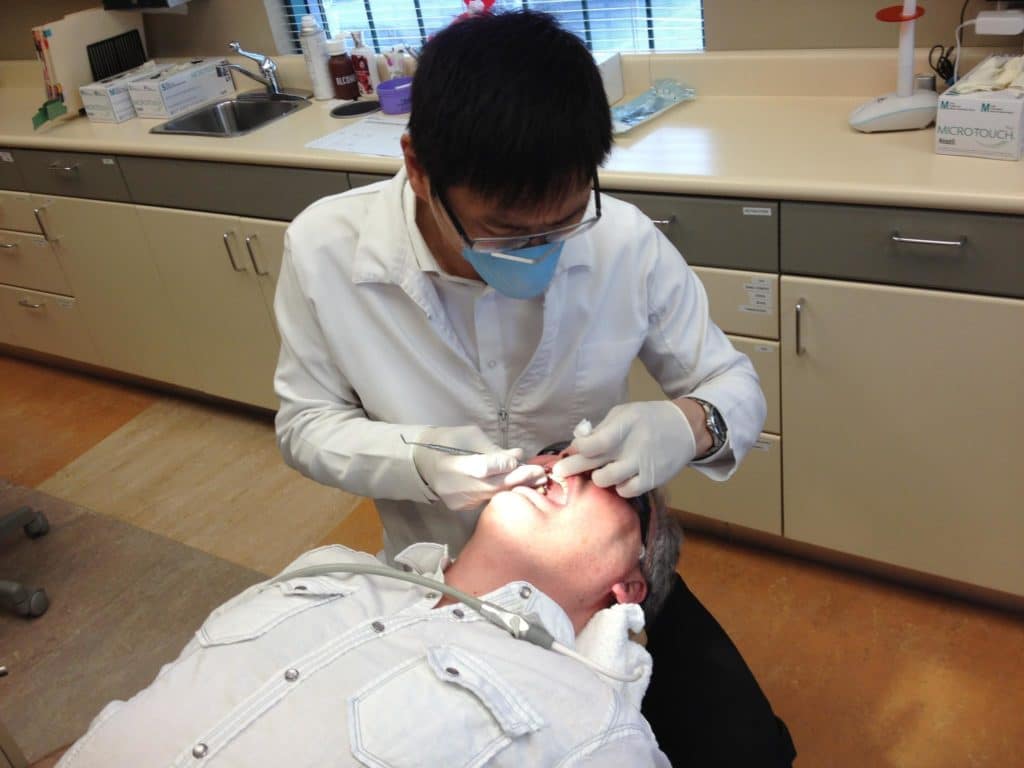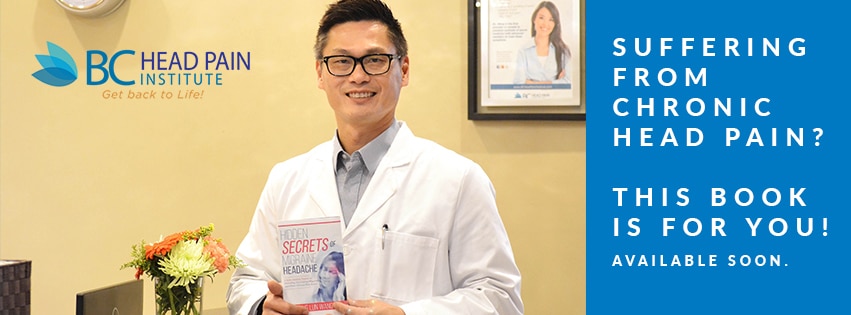
by Dr. C Lun Wang | Jul 26, 2017 | Uncategorized
People who get migraines know that when you feel one starting, you want to find a way to stop it as soon as possible. Unfortunately, this can be difficult as in a lot of cases the cause of the migraine is unknown. One possible cause of migraines that may be worth looking into if you suffer from migraines is triggers in the mouth and jaw.
The sides of your jaw are connected to your skull by two joints called the temporomandibular joints (TMJ). These joints help you to open and close your mouth when you talk, eat, and yawn. In many cases, headache pain can begin as pain or stiffness in these joints. Reasons for pain or stiffness in the jaw can include clenching of the jaw – possibly from feeling stress, or teeth grinding during sleep. Many people who do these things may not even realize they are doing them, even though the habits may be contributing to their migraines.
Signs that you may clench your jaw or grind your teeth include flat, broken, or chipped teeth; sensitive teeth; pain and soreness in the jaw or face; a tired or tight feeling jaw; or earaches with no other war problems. TMJ pain may also be cause by the way a person’s bite is lined up. If the bite is uneven, the muscles in the jaw may need to work harder or unevenly to bring the jaw back together. Over time this can cause a great deal of jaw pain. Additionally, people who use their jaw a lot such as frequent gum chewers may find that they get pain and soreness in the jaw, which can result in headaches.
If you have issues with migraines, and suspect you may also have jaw or face pain – it may be worthwhile to have a dentist check your teeth and jaw to determine if TMJ pain may be attributing to the migraines. The dentist may recommend treatment such as a mouth guard to avoid clenching or grinding of the teeth, or dental treatments to correct your bite if necessary.
For people who get migraines, and suspect that it may be caused by a dental issue, it may be a good idea to check in with a dentist. Additionally, trying to avoid habits such as chewing the fingernails, holding a phone between the shoulder and ear, chewing gum frequently, and eating sticky foods can help to reduce TMJ pain and subsequent migraines.

by Dr. C Lun Wang | Apr 24, 2017 | Uncategorized
Temporomandibular joint disorder (or TMJ) is the name for a group of issues which cause pain in the jaw and facial muscles that control the jaw. While the specific cause of TMJ is yet unknown, treatments and aids for the pains associated with TMJ are plentiful.
In many cases, jaw problems will resolve themselves within a few weeks to months. In order to help with the process of getting back to normal, and to avoid future issues with TMJ, the following aspects of treatment can be looked at.
To avoid pain associated with TMJ, it is best to avoid clenching or stress to the jaw, excessive chewing of gum, and holding a telephone between the ear and the shoulder – which may irritate jaw and neck muscles. If you are currently experiencing TMJ pain or dysfunction, the following therapies may provide some relief:
Eating a Soft Diet. Soft, easy-to-eat foods allow the jaw to rest while recovering from TMJ pain. Hard, crunchy, and chewy foods can cause further pain to those already experiencing TMJ pain. It is best to avoid stretching the jaw open to accommodate larger food items.
Ice & Heat. An ice pack will help to decrease inflammation and help to numb the pain associated with TMJ. Make sure not to place ice directly on the skin, and do not use ice for more than 10 minutes. Using a heat pack or hot water bottle can also provide relief from TMJ by improving jaw function and reducing the pain. Be careful not to burn your skin when using hot packs.
Pain Medications. Pain medications such as short term use of over the counter analgesics may provide temporary relief from jaw pain. If necessary, your doctor can prescribe you with a stronger medication if the symptoms cannot be helped by an over the counter product.
Jaw Exercises. Both strengthening and stretching exercises should be considered to help with TMJ pain. Strengthening exercises have been shown to help avoid future instances of TMJ once recovered, and stretching exercises are used to help with range of motion and pain. Your health care provider will be able to walk you through a series of exercises that will be appropriate for your case of TMJ.
Relaxation Techniques. TMJ can be caused by stress, so finding a great routine for relaxation can prove to be very helpful. Deep, slow breathing can help with pain and stress, and some people have found that yoga or massage therapy helps with their TMJ. It is important to also make a concentrated effort to relax the facial muscles, lips, and to keep the teeth apart.
While TMJ typically resolves on its own after a number of weeks, it’s important to solve the reason behind the issue in the first place. If your TMJ pain is reoccurring, or getting worse with time, it may be time to seek professional advice.

by Dr. C Lun Wang | Mar 30, 2017 | Uncategorized
In British Columbia, almost twenty percent of adults report regular, heavy alcohol-consumption. This begs the question, where is the line between enjoyment and addiction? Here are five signs that might mean that you (or someone you love) could be addicted to alcohol:
- Secrecy
Choosing to drink alone, or in secrecy, is often a sign of alcoholism. Often this is coupled with feeling guilt or shame about drinking.
- Neglecting Responsibilities
Performing poorly at work, failing classes, or skipping out on appointments and responsibilities are all signs of alcoholism – and can happen either due to hang overs, or due to the desire to drink being stronger than the desire to fulfill commitments.
- Using Alcohol to De-Stress
A majority of alcohol addiction problems start with using alcohol to relax and self-soothe. Reaching for the bottle after a rough day or stressful situation conditions the brain to crave it after every stressful event.
- Drinking at Inappropriate Times
Knowing that they will need to be in a potentially dangerous situation, such as driving a car or operating a boat, yet still choosing to drink is often a sign of addiction to alcohol. This can be attributed to either a lack of control, or a lack of care in relation to the level of care for having a drink.
- Inability to Quit
At times, the drinker may express a desire to quit or may try to quit, but will not be able to follow through. This also couples with the inability to control how much or when the person drinks.
These signs, along with others, could be indications of an addiction to alcohol, and may indicate an appropriate time to contact an alcohol counsellor. Anyone who wants to begin the process of breaking the addiction should prepare themselves for the symptoms of alcohol withdrawal syndrome, which may include anxiety, nausea, and headache, as well potential for irritability or mood swings.
by Dr. C Lun Wang | Jan 20, 2017 | Uncategorized
Headaches are just that, your head aches. When you are suffering from a headache and seeking medical advice, a common question you will hear is “what type of headache do you have”? Knowing the different types of headaches and their causes, can help find the most effective treatment.
Some common headaches include:
Tension Headache
A tension headache begins slowly and can be felt across the forehead just above the eyes. This type of headache may feel as though a tight band is around your head. Radiating pain down the back of the neck and into the shoulders. A pain level of mild to moderate. Tension headaches can last for a few hours; depending on your stress level, a tension headache can last for several days. Unfortunately, due to work, health and other contributing factors, tension headaches can become a chronic ailment, requiring intervention from your doctor.
Cluster Headache
Cluster headaches behave just as their name describes, in clusters. Several headaches or groups of headaches can come on in waves lasting 20 minutes or longer. Typically, a cluster headache is very severe on the pain scale and for the average suffer come on suddenly in the middle of the night. Other side effects of a cluster headache include nasal stuffiness, drooping eyelid and tearing of the eyes. Although rare, cluster headaches can afflict a sufferer for weeks and or months at a time. Non-life threatening, cluster headaches can be treated by your doctor, making them shorter and or less severe.
Sinus Headache
Sinus headaches are very common for those that live in damper climates like Vancouver. A sinus headache can be an early sign of a sinus infection. A sinus headache will present with a lot of pressure in the areas of your eyes, forehead and nose. Putting your head forward can cause that pressure and pain increase. A sinus headache is usually accompanied by congestion, a runny nose, fatigue and an achy feeling in your upper teeth or gums.
Migraine Headache
A migraine can be debilitating, with severe throbbing pain typically on one side of the head. Migraine sufferers have reported their headaches lasting from hours to days, usually requiring them to be in complete silence and darkness. For some, a migraine can present early warning signals called “auras” including flashes of light, a tingling sensation in their face, or blind spots. Recurring migraines should be treated by your doctor to confirm there is not an underlying medical concern causing the migraine.
Headaches are disruptive, whether it be a tension, sinus, cluster or migraine headache. Knowing the symptoms of the different types of headaches will better assist you and your doctor in determining what is the best treatment to eliminate the pain and other symptoms that can come with a headache. Treatment centres like the BC Head Pain Institute in Vancouver can work with you to determine the type, cause and treatment of your head pain.
by Dr. C Lun Wang | Dec 2, 2016 | Blog, Uncategorized
Have you ever wondered “What’s that ringing in my ears?” It might be what is referred to as Tinnitus. It’s a legitimate medical condition that we treat at the BC Head Pain Institute in Vancouver and Surrey BC. While it is localized to the ears, it isn’t “all in your head.”
There are several causes of tinnitus:
Earwax
A buildup of wax can cause tinnitus symptoms. Removing the excess wax may alleviate the pressure that is making the ringing or hissing sensation happen. Your ears will breathe easier and so will you, without that annoying ringing.
Migraine
Tinnitus can accompany a migraine, or present in the migraine’s recovery phase. Reducing migraine triggers can reduce the frequency of tinnitus. There are pharmaceutical options that can cut down on the frequency of migraines, as well as to alleviate pain.
Loud noises
If you are exposed to loud noises, whether it by your occupation or recreational environment, you might experience some tinnitus after exposure. It is important to use proper ear protection wherever possible, to reduce damage to your hearing and make it less likely that tinnitus will occur.
Medications
Tinnitus can be a side effect of existing drugs you are taking to treat other conditions. Check the listing of possible side effects to see if your normal regimen is impacting your ears and giving you that ringing noise.
Ear infection
If you have an infection, tinnitus may also be present. Make sure to complete your antibiotics to get rid of the bacteria causing your condition. Antibiotic drops might also be helpful to alleviate discomfort.
Jaw issues
A common condition called TMJ (temporomandibular joint syndrome) can also cause tinnitus. There are a variety of surgical and non-surgical options to treat TMJ, which may reduce the amount of tinnitus you are experiencing.
Tinnitus is not “all in your head” and the ringing can be decreased or eliminated with medical intervention by your dentist, orthodontist or doctor. Although sometimes Tinnitus goes away all on its own, a specialist at BC Head Pain is there to help you when it doesn’t.
by Dr. C Lun Wang | Oct 28, 2016 | Blog
Welcome to the BC Head Pain Institute Blog. I’m Dr. C. Lun Wang and I’d like to tell you how the Institute all come into being.

Dr. C. Lun Wang
Whenever you see dentists portrayed in movies or on television, you will see the dentist holding a drill or a big needle full of Novocain. It is a given that dentists deal with pain and head pain every day and must learn ways to control them effectively. The first time I used a needle on a real person was during the beginning of our clinical term in third-year dental school. All of the third-year dental students gathered in the main clinic—you could see the tension in everyone’s eyes and even in some people’s hands as we prepared to perform our very first injection, using each other as guinea pigs. The idea was to pair up, and we would try to do a nerve-block on each other. We had learned all the anatomy and physiology and pharmacology about this procedure, but now we had to actually do it. It was a relatively easy procedure that, as practicing dentists, we would do every day. On that day, I injected my partner with Lidocaine, which is supposed to freeze the nerve in question for about 2 hours. Well, I hit the jackpot that day—I actually nicked the major nerve to the lower jaw with my needle, which is rarely done, and when that happens, the freezing can be very profound. In this case, the freezing lasted around 8 hours!
Over the next two years, we learned all about drilling and filling and other fun dental stuff. But most of all, we learned about pain control in the head and neck areas, which is crucial before, during and after most procedures. There is another type of pain that we deal with on a daily basis that is persistent: chronic pain.

-
According to the World Health Organization, 1 in 20 people in the developed world suffer with a daily tension headache.
-
150 million workdays are lost annually to headaches.
-
Over 12% of North Americans suffer from migraine every year.
Has chronic head pain reached epidemic proportions? With all our advances in modern medicine, why have we not found a cure for headaches? Yes, there are all kinds of treatments for headaches, and millions of patients benefit from it; however, there is a large group of chronic head-pain patients who have eluded all conventional medical treatments.
Chronic headaches and migraines are typically treated by physicians, which is the right place to start in most cases. However, over 80% of pain conditions in the head and neck areas actually involve the oral cavity and the jaw. Injuries resulting from improper force on the muscles, joints and other soft tissues in the oral cavity and in the head and neck areas contribute to a large percentage of chronic headaches and migraines. These patients with a complex set of symptoms including tinnitus, vertigo, and others, collectively describe a condition called Dentomandibular Sensorimotor Dysfunction (DMSD).
Until recently, there has not been a way to properly and systematically assess this condition, leading to partial or ineffective treatment. The breakthrough came with the realization that we must incorporate the expertise of advanced dentistry and medical rehabilitation techniques in order to address the needs of this type of head pain. A combination of technologically advanced assessment tools from both medicine and dentistry is used to pinpoint areas of injury. Dentists, with their basic medical training and extensive knowledge in the head and neck areas, are the best choice to carry out these assessments and procedures.

With this blog series, I will talk about the hidden secrets that have kept so many chronic head-pain patients from finding effective, lasting relief from their pain. We will examine why they have tried every type of treatment out there and are still suffering. We will discuss the frequent causes of chronic pain in the head and neck areas, and all the symptoms associated with these disorders.
Best of all, we will talk about effective treatment for chronic headache sufferers. I will explain why these cases have slipped through the cracks of our medical system, and why dentists hold the key for solving them. Since 1 in 5 people in the general public will have suffered one or more of these pain conditions in the past year, the assessment and treatment we talk about here will be essential to you or someone you know. I look ofrward to you join us on out journey of helping hundreds of people, maybe just like you journey on the path to zero head pain.

by Dr. C Lun Wang | Oct 12, 2016 | Blog
 I know it’s hard to believe, but it’s true, I am the author of a migraine book!
I know it’s hard to believe, but it’s true, I am the author of a migraine book!
This is my first book, and I chose to write about a topic that was new to me only 4 years ago. It is on migraines and headaches.
You are wondering why a dentist would be qualified to write a book on headaches and migraines?
Well, that is a very interesting question, one that I would not even have thought to ask myself just a few years ago. But life has many twists and turns, and some we would never expect or could ever anticipate!
This is part of my professional journey, one that is born out of this fantastic dental profession, the breadth of which I am starting to appreciate. My, how interesting life can be.
I have always treated patients with various types of dental ailments, and occasionally face and jaw pain. However, there is a small group of head pain patients that also experience chronic headaches, migraines, tinnitus and vertigo. I was not able to help them, and neither has the medical profession. They suffer for months, and some even for years and decades!
One day, one of my own orthodontic patients, K., came to see me.
He had braces years ago, and finished with a beautiful set of teeth. That day when I saw him again, his bite was completely off, and he was suffering from chronic headaches daily. It was so bad that he could not study or work for many months. He tried conventional medical therapies and drugs, none of which worked, and the side effects made him worse! He settled on living in the basement of his home, where it is dark and quiet, and using a daily dose of medicinal marijuana to keep the pain in check.
I was intrigued by it, but never thought it was something within my realm of treatment. That is until one day I came upon a system that describes and treats this precise set of symptoms. I did further research into this, and found that dentists hold the key to solving these problems!
I applied this new method to K. and in a few short weeks, he was getting better!
This is how I came to start my new clinic, the BC Head Pain Institute, to help these pain patients that have lost hope.
This is also why I have written this book, to get the message out there, that no one needs to go through months of chronic pain before finding relief.
For a full account of my discoveries, join my launch team and learn how this can help you or your love ones, and help me get the word out to all those sufferers!

by Dr. C Lun Wang | Jul 27, 2016 | Blog
BC Head Pain Institute was recently founded by Dr. Cheng Lun Wang in effort to provide proven relief to sufferers of head, neck, jaw and migraine pain. Dr. Wang has undergone extensive training to detect the source of pain and determine the most effective course of treatment. An common underlying cause of chronic head, neck and jaw pain is attributed to an imbalance of dental forces. Dr. Wang assesses each patient and provides an individual course of treatment.
Many of those who suffer from migraines, chronic head pain, neck pain and ear ringing feel they must adjust their life to accommodate their pain. The team at BC Head Pain Institute is proud to offer cutting edge therapy to patients who have tried other numerous and unsuccessful treatment.
The initial evaluation is a brief, but thorough exam that provides insight into the underlying cause of pain. At that point the team at BC Head Pain can determine a treatment plan. The therapy is comfortable and relaxing and does not require needles or drugs.

by Dr. C Lun Wang | Jul 27, 2016 | Blog
If you have persistent headaches or migraines, the source of your problems may actually be dental in nature. At BC Head Pain Institute, we assess the balance of dental forces to provide lasting headache relief.
Our treatment involves no drugs or injections, and it has provided relief to many of our patients. They are amazed about how well it works, and we love it when thank us for finally bringing them relief from the severe headaches that have hampered their lives.
One problematic thing about persistent headaches is that they can have various causes. As a result, people seeking relief from debilitating pain will search high and low for a treatment that works. We’ve known patients who’ve had CAT scans and MRIs to try to figure out the source of the problem. They’ve tried various over-the-counter and prescription drugs, chiropractors and massage therapists. But if the source of the problem is an imbalance of forces in the teeth and jaw, our treatment can be the answer.
BC Head Pain Institute’s treatment starts with a diagnosis. We will measure the opening and closing of your mouth and quantify the bite forces in your individual teeth. Diagnosis also involves a questionnaire that looks into the details of your symptoms, their history, and medical events of your past.
For treatment, we use a combination of various therapies, including cold laser, microcurrent, massage, and ultrasonic therapy. None these are painful, require injections, or pharmaceuticals. Treatment might last a single session or as many as twelve sessions.
Many patients have told us that their headaches prevented them from functioning normally in the world. They couldn’t go to work, school place, or parties. They couldn’t eat the food they wanted or enjoy a glass of wine. BC Head Pain Institute has made their persistent headaches go away and changed their lives!

by Dr. C Lun Wang | Jul 27, 2016 | Uncategorized
PART 1 of 2 in Dr. Wang’s Migraine Series
Over the past few days, I was contacted by journalists from Vancouver Sun and CBC Radio for my participation and comments on a local tragedy that occurred over the past weekend. If you haven’t heard or read about it already, Randy Janzen of Rosedale BC, committed triple murder before killing himself and setting his house on fire. Mr. Janzen first shot his grown daughter, then his wife and sister. He used a facebook post to explain his horrific actions. The main cause for his initial action was the fact that he can no longer watch his “little girl hurt for one more second”, Janzen claimed he shot his daughter in the head to relieve her of the pain and “severe depression that these migraines caused her.”
Because of the migraine pain that Emily suffered was stated as the prime motivator for Randy’s action, media as been very interested in obtaining and reporting the effects of migraines on a person and their families. Even though Randy did not suffer from migraines himself, there was clear indications that chronic pain such as this affects the psyche of all those around sufferer.
As a frontline health care worker and head pain therapist, we see the affect pain has on the lives of our patients, and the profound impact it has on their loved ones each and every day. We all live with pain, in fact pain is good, and it is our evolutionary warning and defense to keep us from hurting ourselves. When we come into contact with something sharp, or hot, or when we over exert ourselves, our nerves carries a signal to our brain that is interpreted as pain. Our brain then tells our body to find a way to avoid the source of the pain; however, there is a physiological and psychological response to that pain that is extremely negative when pain becomes chronic. Physiologically, there are chemical and cellular changes that can make the patient more sensitive to pain stimulants. The feedback loop from the brain will tell muscles surrounding the area of stimulus to become more tense. Pain will cause a change, and thus an imbalance, in brain chemistry; cause more production of some brain chemicals and less of other chemicals. Pain will also cause a change in brain wave activities, causing anxiety and sleep disorders.










